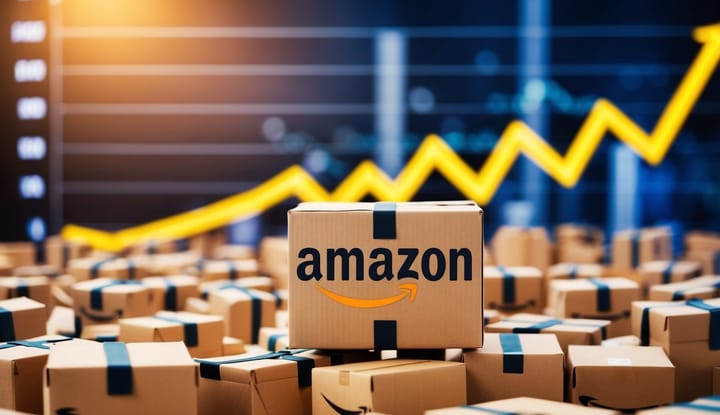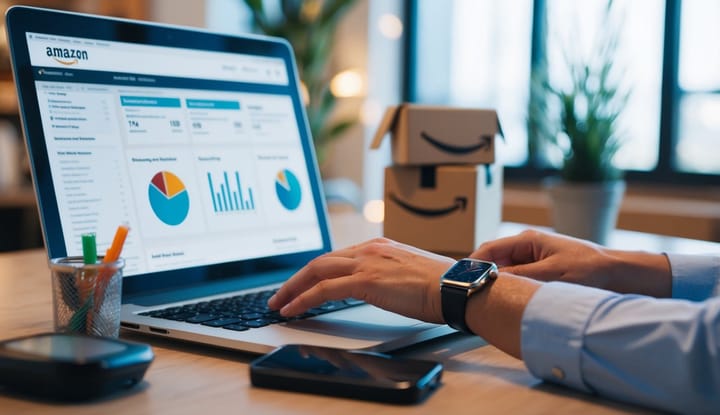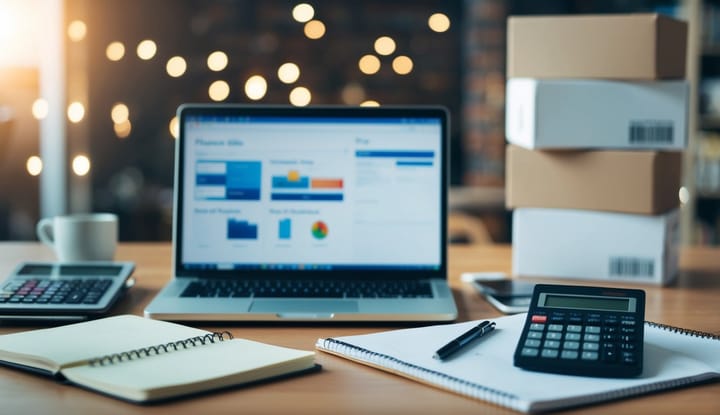Singapore Amazon Sellers: FBA vs Dropshipping Guide [2024]
![Singapore Amazon Sellers: FBA vs Dropshipping Guide [2024]](/content/images/size/w1200/2024/09/v2-igkvn-gavwq.jpg)
Starting an online business brings up a common question: should you choose Amazon FBA or dropshipping? Both methods let you sell products online, but they work in different ways. Amazon FBA works better for sellers who want higher profit margins and can invest more money upfront, while dropshipping suits those who prefer lower startup costs and more flexibility.

With Amazon FBA, you buy products in bulk and send them to Amazon's warehouses. Amazon handles storage, shipping, and customer service. This model needs more money to start but gives you more control over product quality and better profit margins.
Dropshipping lets you sell products without keeping inventory. When customers buy from you, your supplier ships directly to them. This needs less money to start and involves less risk, but profit margins are often smaller than FBA.
Key Takeaways
- Amazon FBA requires higher upfront costs but offers better profit margins and Amazon Prime benefits
- Dropshipping needs minimal startup money and involves less risk with inventory management
- Both models can succeed, but FBA works best for long-term growth while dropshipping offers more flexibility
What Is Amazon FBA?
Amazon FBA (Fulfilled by Amazon) is a service where Amazon handles storage, shipping, and customer service for sellers' products. Sellers send their inventory to Amazon's warehouses, and Amazon takes care of the rest.
How Fulfilled by Amazon Works
Sellers first need an Amazon seller account to access FBA. They list their products on Amazon Marketplace and prepare inventory according to Amazon's guidelines.
Amazon provides shipping labels and requirements for packaging. Sellers ship their products to designated Amazon fulfillment centers.
When customers place orders, Amazon handles:
- Picking and packing items
- Shipping to customers
- Tracking and delivery updates
- Returns processing
- Customer service inquiries
Pros and Cons of Amazon FBA
Benefits:
- Prime shipping eligibility
- Professional warehouse storage
- 24/7 customer service
- Easy shipping process
- Higher search rankings
- Access to Amazon's trusted brand
Drawbacks:
- Storage fees for inventory
- Preparation requirements
- Shipping costs to warehouses
- Competition from other sellers
- Need for inventory management
- Risk of damaged or lost items
FBA works best for sellers with consistent sales and proper inventory planning. The service reduces day-to-day operations but requires careful cost management.
What Is Dropshipping?
Dropshipping lets online sellers run a store without keeping any inventory. The seller acts as a middleman between suppliers and customers, taking orders and having products shipped directly to buyers.
How Dropshipping Works
When a customer places an order in a dropshipping store, the seller purchases that item from a supplier at a lower wholesale price, which is crucial for selling products on Amazon. The supplier then ships the product straight to the customer.
Most dropshippers use platforms like Shopify to create their online stores. They source products through marketplaces like AliExpress or connect with suppliers in the US and other countries.
The seller handles marketing, customer service, and managing the online storefront. The supplier takes care of inventory storage, packaging, and shipping items to customers.
Pros and Cons of Dropshipping
Benefits:
- Low startup costs - no inventory investment needed in the dropshipping model.
- Easy to test new products without risk
- Location independence - run the business from anywhere
- Simple to scale up or down quickly
Drawbacks:
- Lower profit margins due to retail pricing
- Less control over shipping times and quality
- More competition since entry barriers are low
- Supplier issues can affect customer satisfaction
Many dropshippers now sell through multiple channels including their own websites, Amazon, and other online marketplaces to reach more customers using the dropshipping model. Product selection and reliable suppliers make a big difference in success.
Key Differences Between Amazon FBA and Dropshipping
Amazon FBA and dropshipping represent two distinct approaches to selling products online, with major differences in how sellers manage inventory, handle fulfillment, and start their businesses.
Startup Costs and Investment
FBA requires more upfront capital since sellers must purchase inventory in bulk. Initial investments typically range from $2,000-$5,000 for inventory plus FBA fees.
Dropshipping needs minimal startup funds, often under $500. Most costs go toward website setup and marketing rather than inventory.
FBA sellers pay storage fees, fulfillment costs, and referral fees to Amazon. These fees eat into profit margins but provide access to Prime customers.
Dropshipping has lower ongoing costs but thinner profit margins, typically 10-30% per sale versus 25-40% for FBA.
Order Fulfillment and Logistics
FBA sellers ship inventory to Amazon warehouses. Amazon handles storage, packing, shipping, and customer service.
Prime badge eligibility gives FBA products fast 1-2 day shipping speeds.
Dropshippers never touch inventory. Suppliers handle shipping directly to customers, which can take 1-3 weeks for delivery.
Quality control is easier with FBA since sellers inspect products before sending to Amazon. Dropshippers rely on suppliers for quality assurance.
Product Selection and Sourcing
FBA works best with unique, branded items or products with high demand and decent margins, making it best for sellers in 2024. Sellers often import from manufacturers or buy wholesale.
Competition tends to be lower in FBA since not everyone can afford bulk inventory purchases.
Dropshippers can list thousands of products without buying inventory. Many sell trending items from marketplaces like AliExpress.
Finding reliable suppliers proves crucial for dropshipping success. Bad suppliers lead to shipping delays and quality issues, which can be detrimental when selling on Amazon.
Product research matters more in FBA due to inventory investment risks.
Profitability and Revenue Potential

Both Amazon FBA and dropshipping offer different paths to making money in ecommerce. The profit potential varies based on costs, pricing strategies, and operational efficiency.
Profit Margins
Dropshipping typically yields profit margins between 30-50% after accounting for supplier costs and shipping fees. These margins can increase through supplier negotiations and bulk pricing.
Amazon FBA sellers often see higher margins of 50-80% due to Amazon's efficient fulfillment network and bulk shipping rates. The trade-off comes from higher initial inventory costs.
Typical Profit Margins:
- Dropshipping: 30-50%
- Amazon FBA: 50-80%
Scalability and Growth
Dropshipping scales quickly with minimal upfront investment. Adding new products requires no inventory purchases or warehouse space.
FBA businesses need more capital to grow but can expand more sustainably. Amazon's infrastructure supports rapid scaling once inventory systems are in place.
Growth metrics to track:
- Sales volume
- Product range expansion
- Market reach
- Customer retention
Revenue Streams
FBA sellers generate income through direct product sales and can add private label items to boost profits. Many successful sellers focus on 3-5 profitable product categories.
Dropshipping allows testing multiple product lines with low risk. Revenue comes from price markups and volume sales across different platforms.
Additional income opportunities:
- Bundle deals
- Cross-selling
- Seasonal promotions
- Multi-channel selling
Marketing and Customer Experience

Marketing strategies and customer satisfaction play crucial roles in both Amazon FBA and dropshipping business models. Each approach offers distinct advantages and challenges for reaching customers and building brand loyalty.
Traffic and Promotion Strategies
Amazon FBA sellers benefit from Amazon's massive built-in traffic and advanced PPC advertising platform. They can target specific keywords and compete directly for Amazon's buy box.
Product listings with A+ content and high-quality images rank better in Amazon's search results. FBA sellers also gain automatic eligibility for Prime badges, which increases visibility.
Dropshipping merchants must generate their own traffic through social media, Google Ads, and content marketing. This gives them more control over their marketing strategy but requires more expertise and effort.
Branding and Private Label
FBA sellers can create strong private label brands with custom packaging and inserts, which Amazon FBA allows. Amazon's brand registry provides extra protection and marketing tools.
Dropshipping makes it harder to build a unique brand since products come directly from suppliers. Many dropshippers sell generic items with minimal customization options.
Private label FBA products often command higher profit margins due to brand recognition and perceived value.
Customer Service and Satisfaction
Amazon handles most customer service issues for FBA sellers, including returns and refunds. This saves time but limits direct customer interaction.
Prime shipping speeds lead to higher customer satisfaction rates for FBA products. Two-day delivery is standard for Prime items.
Dropshippers must manage all customer communications themselves, unlike sellers who use Amazon FBA. This creates opportunities for personalized service but increases workload.
Longer shipping times from overseas suppliers can frustrate dropshipping customers and lead to more complaints.
Which Business Model Is Better for You?

Picking between Amazon FBA and dropshipping comes down to your resources, goals, and business strategy. Each model has distinct advantages that work better for different sellers and product types.
Flexibility and Risk Management
Dropshipping offers more freedom to test products with minimal upfront investment. Sellers can list items on multiple platforms like Shopify stores without holding inventory.
Amazon FBA needs more initial capital for inventory purchases and storage fees. The trade-off brings better profit margins and faster shipping speeds.
Risk levels differ between the models. Dropshipping carries lower financial risk since no inventory investment is needed. FBA requires careful inventory planning to avoid storage fees and unsold stock.
Choosing the Right Product Category
Small, lightweight items work well for both FBA and dropshipping. These products keep shipping costs low and storage fees minimal.
Trendy or seasonal products fit better with dropshipping due to quick market changes. Sellers can add or remove items without inventory concerns.
Stable, everyday products match better with FBA. The steady demand helps maintain the Buy Box position and builds a loyal customer base.
Private label products benefit from FBA's professional fulfillment and Amazon's trust factor. These items can command higher prices and margins.
Frequently Asked Questions

E-commerce sellers must weigh shipping speeds, profit potential, startup costs, and inventory management when choosing between Amazon FBA and dropshipping platforms.
Q: What are the key differences between Amazon FBA and dropshipping business models?
Amazon FBA requires purchasing inventory upfront and sending it to Amazon's warehouses. Amazon handles storage, shipping, and customer service.
Dropshipping eliminates inventory costs since products ship directly from suppliers to customers. The seller acts as a middleman and manages marketing and customer acquisition.
Q: How do profit margins compare between dropshipping and Amazon FBA?
Amazon FBA typically yields 20-30% profit margins after fees, storage costs, and product costs. Prime shipping status helps justify higher product prices.
Dropshipping margins range from 15-25% due to supplier costs and marketing expenses. Lower overhead costs help offset smaller margins per sale.
Q: What are the benefits and drawbacks of using Shopify for dropshipping over Amazon FBA?
Shopify gives sellers complete control over branding, website design, and customer relationships. Sellers can build unique stores and marketing funnels.
The tradeoff is less built-in traffic compared to Amazon's massive customer base. Marketing costs increase to drive visitors to a standalone store.
Q: Which platform offers greater scalability for a new e-commerce business: Amazon FBA or dropshipping?
Amazon FBA scales effectively with established infrastructure for storage and shipping. Sellers focus on inventory management and product listings.
Dropshipping requires more systems and automation as orders increase. Managing multiple suppliers and shipping times becomes complex at scale, especially when comparing dropshipping vs FBA.
Q: How does the level of control over inventory and branding differ between Amazon FBA and dropshipping?
FBA sellers maintain inventory control but must follow Amazon's strict policies. Product packaging and inserts have limitations.
Dropshipping offers more brand flexibility but less control over product quality and shipping times. Sellers depend on suppliers' inventory and fulfillment, which can be a challenge when using the dropshipping model.
Q: Can newcomers to e-commerce expect faster success with dropshipping or Amazon FBA?
Dropshipping has a faster launch time with minimal upfront investment. New sellers can test products without purchasing inventory.
FBA requires more initial capital and setup time but provides immediate access to Prime customers. The learning curve focuses on Amazon's requirements and systems.
Q: What’s the deal with Amazon FBA vs dropshipping?
So, when you’re looking at Amazon FBA vs dropshipping, you’re comparing two different ways to sell products. Amazon FBA (Fulfillment by Amazon) lets you store your products in Amazon’s warehouses, and they handle shipping for you. On the other hand, dropshipping means you don’t hold any inventory; when a customer buys something, you just order it from a dropshipping supplier, and they ship it directly.
Q: Why should I choose between Amazon FBA and dropshipping?
Choosing between Amazon FBA and dropshipping really depends on your business goals. If you want to scale quickly and have less hands-on work with shipping, FBA might be the way to go. But if you want low upfront costs and flexibility, then dropshipping could be your best bet. It's all about what fits right for your business!
Q: What are the pros of Amazon FBA vs dropshipping?
When comparing Amazon FBA vs dropshipping, FBA offers great perks like Prime eligibility, faster shipping, and customer service handled by Amazon, which is better in 2024. On the flip side, dropshipping has lower startup costs and no need for inventory management, so it’s easier to start.
Q: What are the cons of Amazon FBA vs dropshipping?
The cons of Amazon FBA vs dropshipping usually lean towards FBA having higher fees and needing to manage inventory. For dropshipping, you might face longer shipping times and less control over product quality, depending on your dropshipping supplier.
Q: Can I do dropshipping on Amazon?
Yup! You can absolutely do dropshipping on Amazon, but it’s essential to follow Amazon's policies. They have strict rules about how to handle fulfillment and customer service, so make sure you’re familiar with those before diving in.
Q: Is Amazon dropshipping a viable business model in 2024?
Definitely! Amazon dropshipping is still a popular ecommerce business model in 2024, especially for those who want to test products without the risk of inventory costs. Just remember, competition is fierce, so you'll need a solid strategy to stand out.
Q: How does Amazon FBA provide an edge over dropshipping?
Amazon FBA provides an edge by offering services like quick shipping and returns, which can enhance customer experience. Plus, products fulfilled by Amazon often have better visibility and credibility, which can lead to higher sales.
Q: What should I consider when comparing Amazon FBA vs dropshipping?
When comparing Amazon FBA vs dropshipping, think about your budget, how much time you can invest, and your long-term goals. It’s about finding what works best for you and your ecommerce vision!
Q: What’s the best option for sellers in 2024?
The best option for sellers in 2024 really depends on your personal situation. If you have the capital for inventory and want to scale, using FBA might be the better option. But if you’re starting out and need flexibility, dropshipping is still a fantastic choice!
Q: How can I start dropshipping successfully?
To start dropshipping successfully, research your niche, find reliable dropshipping suppliers, and set up a killer Amazon store to take advantage of what Amazon FBA offers. Make sure to optimize your listings and keep an eye on customer service to build a good reputation!
Want to Grow Your FBA Sales with Data That Matters?
Join our mini-course at WAH Academy and learn the key metrics every Amazon seller should track to boost profits and scale smarter.
No fluff. Just expert tips that make a real difference.
Tap below to get started.



